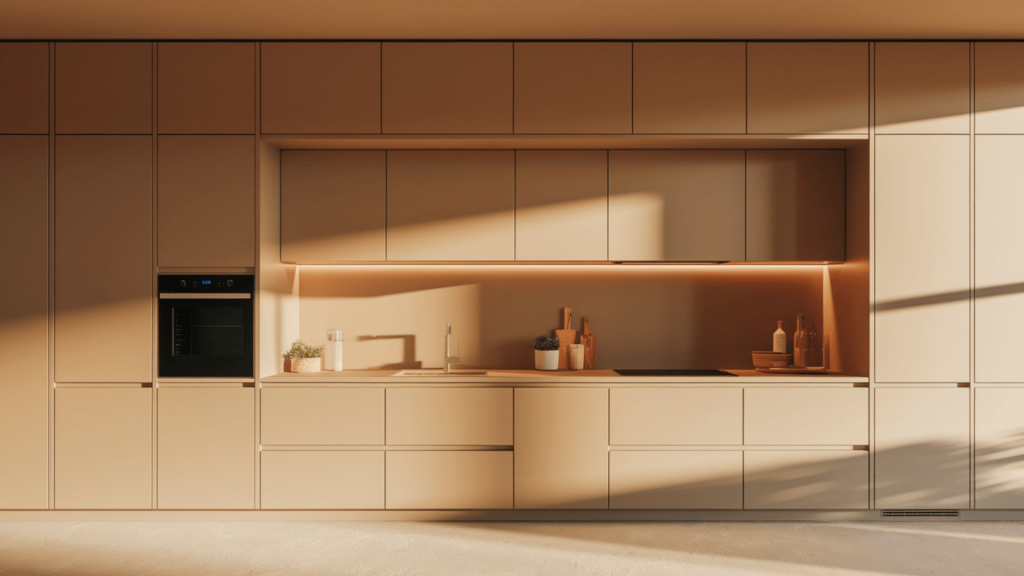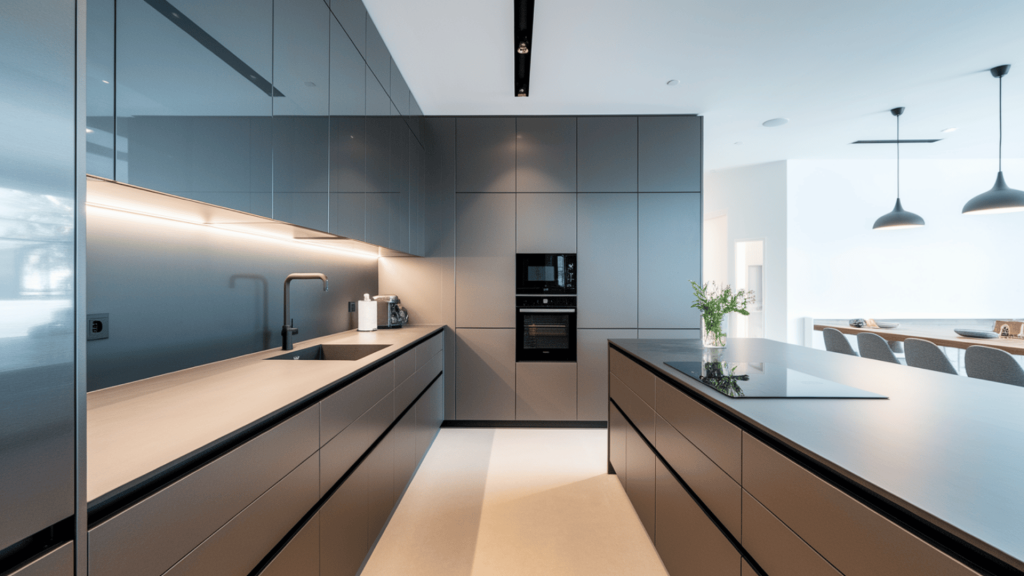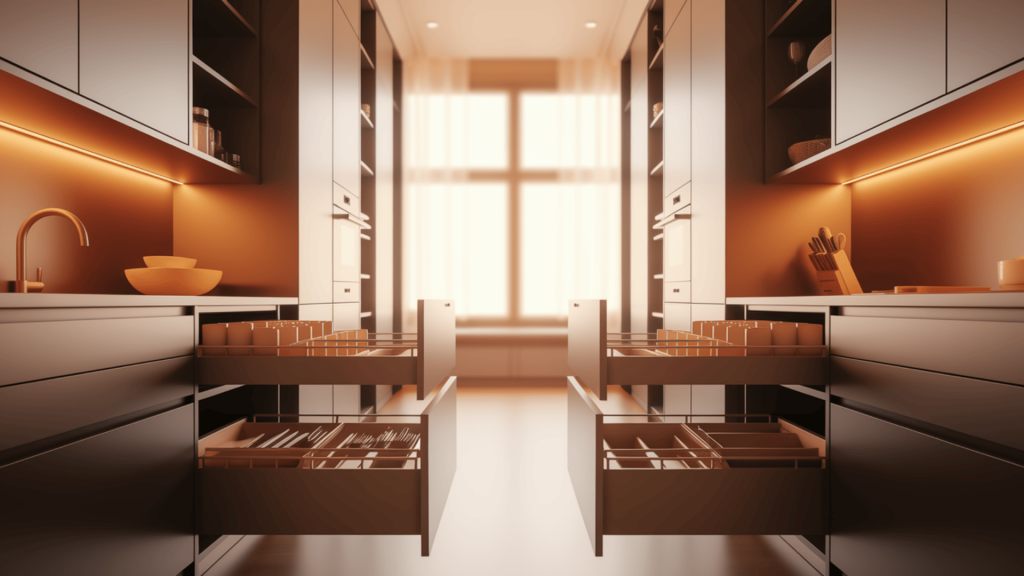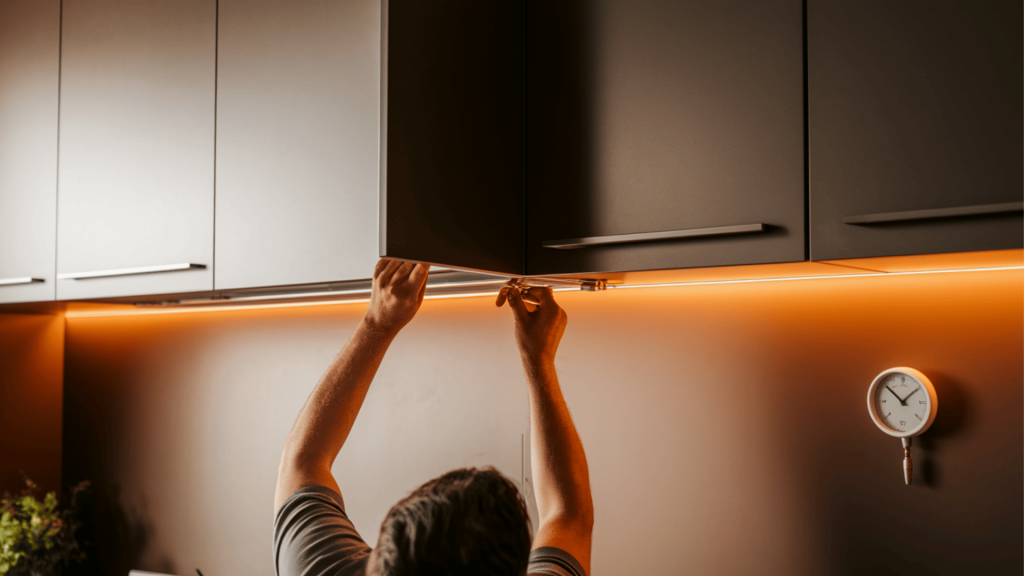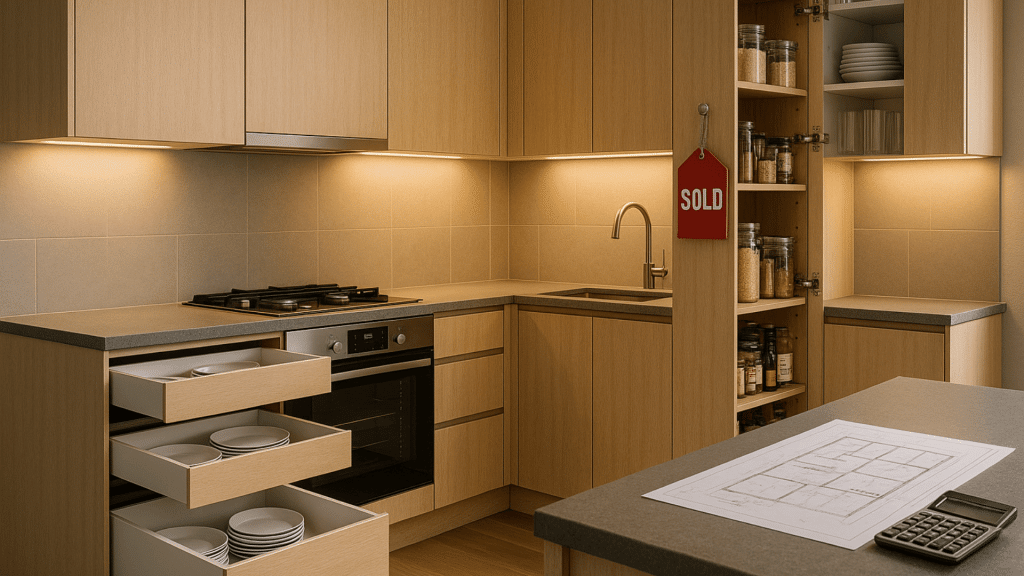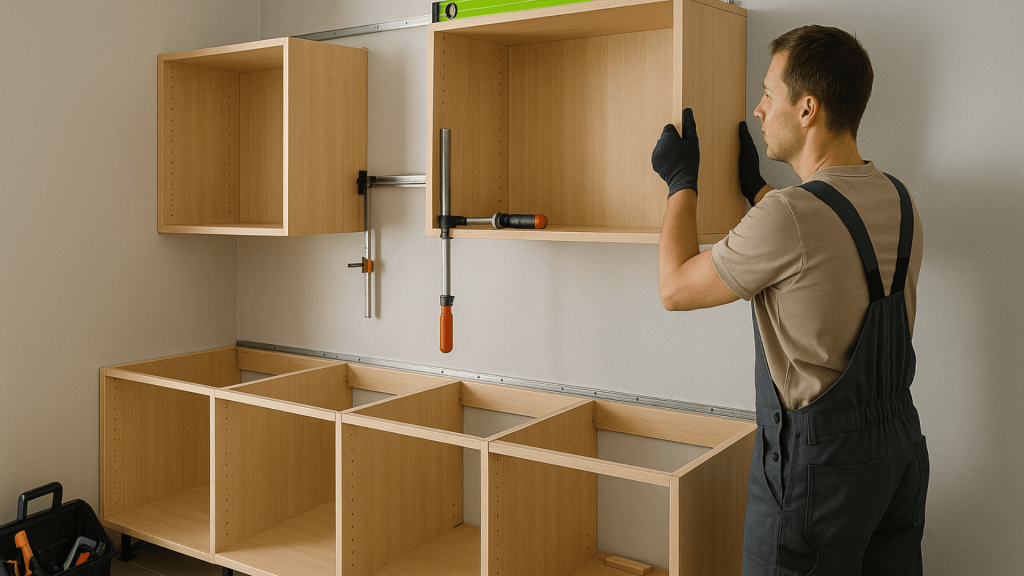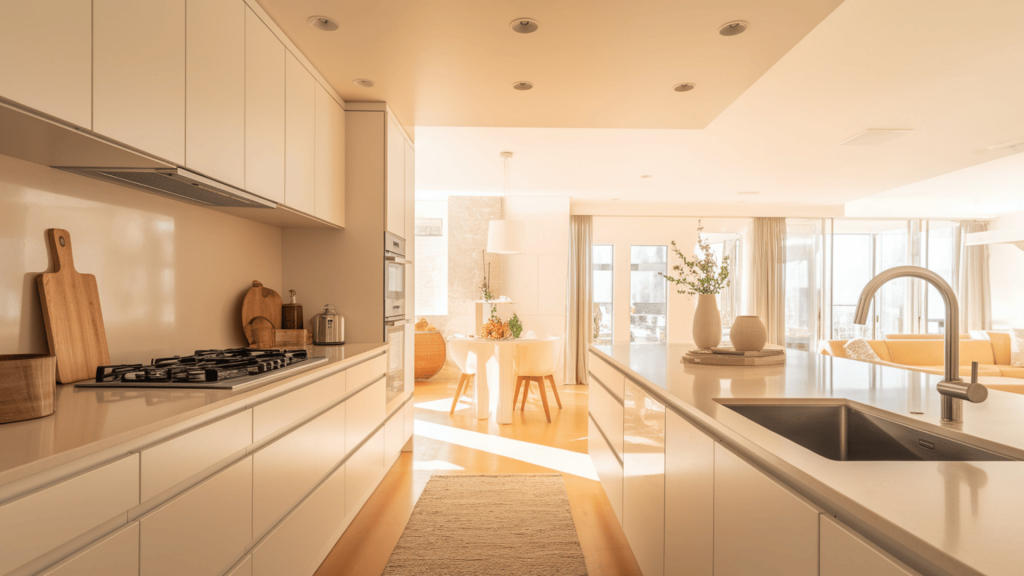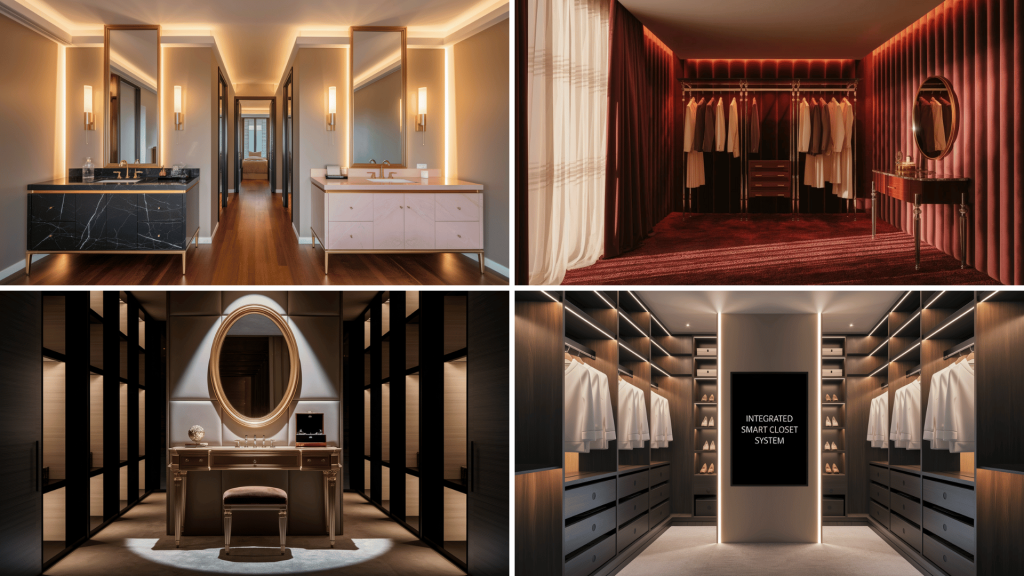Looking to update your kitchen with a modern twist? Frameless cabinets might be the perfect solution.
These sleek storage options have taken kitchen design by storm, offering clean lines and maximum space efficiency.
Unlike traditional cabinets with their bulky face frames, frameless designs give you full access to every inch of storage.
Originally popular in Europe, these cabinets now feature prominently in stylish American homes.
Ready to find out if this cabinet style matches your needs?
Let’s look at what makes frameless cabinets stand out and how they could change the way you use your kitchen.
Frameless Cabinets Explained
Frameless cabinets have become increasingly popular in American homes over the past decade.
Understanding this modern option is essential if you’re planning a kitchen renovation or simply curious about different cabinet styles.
This style first gained traction in Europe before making its way to American kitchens.
Brands like IKEA helped popularize the look, though many custom cabinetry makers now offer frameless options across various price points.
Let’s look at the key features that set frameless cabinets apart:
- No face frame on the cabinet front
- Doors attach directly to the cabinet sides
- About 10% more storage space
- Hidden European-style hinges
- No center aisle between doors
- Requires precise installation
Many homeowners choose frameless cabinets for their smooth look and smart use of space.
The lack of a frame means no center stile in double-door cabinets, making it easier to store and retrieve large items.
How Frameless Cabinets Differ from Framed Cabinets
When renovating your kitchen, knowing the differences between cabinet types helps you make the right choice.
Frameless and framed cabinets have distinct features that affect both look and function.
The key difference: framed cabinets have a wooden face frame, while frameless ones don’t.
This simple distinction impacts storage space, appearance, and installation requirements.
| FEATURE | FRAMELESS CABINETS | FRAMED CABINETS |
|---|---|---|
| Structure | No face frame | Has a wood frame |
| Door Attachment | Connects to cabinet sides | Mounts to the face frame |
| Interior Space | Full-width access | Frame reduces usable width |
| Drawer Width | Wider drawers possible | Limited by frame |
| Hinge Type | Mounts on cabinet walls | Attaches to a hardwood frame |
| Door Options | Full overlay only | Partial, full, or inset options |
| Material Needs | Thicker cabinet box | Can use thinner materials |
Frameless cabinets offer more storage space and a modern look, while framed options provide more door style choices and often better structural support.
Benefits of Choosing Frameless Cabinets
Choosing the right cabinet style impacts both how your kitchen looks and functions.
Frameless options bring several advantages worth considering for your next renovation project.
The lack of a front frame creates more usable interior space, which is especially valuable in smaller kitchens where every inch counts.
Without center stiles or frame edges taking up room, larger items can be accommodated and accessed more easily.
Clean, Contemporary Style
The smooth, uninterrupted face of frameless cabinetry creates a modern look that works well in many current design trends.
The clean lines and minimal gaps between doors and drawers offer a sleek, put-together appearance.
This style particularly complements:
- Contemporary homes
- Minimalist designs
- Open concept layouts
- Urban apartments
Many interior designers choose frameless cabinets as the foundation for sleek kitchen designs.
Their simple profiles create a perfect backdrop for statement lighting, fixtures, and hardware choices.
Flexible Organization Options
Without frame elements restricting the interior, frameless cabinets accommodate a wider range of storage solutions:
- Pull-out shelving fits with minimal clearance issues
- Drawer systems can be wider and more functional
- Adjustable shelving becomes easier to implement and modify
- Custom organization inserts fit more precisely
Many homeowners find these cabinets make kitchen organization simpler and more effective, helping maximize storage in even the most compact spaces.
Disadvantages and Common Challenges of Frameless Cabinets
While frameless cabinets offer many benefits, they also come with certain limitations you should consider before making your final decision.
The absence of a front frame means these cabinets lack some structural reinforcement found in traditional options.
This can affect long-term durability, especially in busy households where cabinets see heavy daily use.
Installation presents another challenge.
Without a frame to hide small gaps or imperfections, frameless cabinets require extremely precise installation.
Walls that aren’t perfectly straight can create noticeable problems with alignment and door function.
Hardware and Maintenance Concerns
The hinges on frameless cabinets attach directly to the cabinet sides, typically made from engineered wood products.
This can lead to:
- More frequent need for hinge adjustments
- Potential for stripped screw holes if hardware is removed
- Greater sensitivity to humidity changes affecting door alignment
Many homeowners find they need professional help for repairs and adjustments more often than with framed cabinets.
Cost Considerations
The precise construction requirements and trendy appeal often make frameless cabinets more costly than traditional options.
The price difference varies by manufacturer but typically runs 10-15% higher for a comparable quality level.
| CABINET GRADE | FRAMED COST (PER LINEAR FOOT) | FRAMELESS COST (PER LINEAR FOOT) | DIFFERENCE |
|---|---|---|---|
| Stock | $70-$150 | $80-$175 | ~15% more |
| Semi-Custom | $150-$250 | $175-$280 | ~12% more |
| Custom | $300-$500 | $330-$550 | ~10% more |
| High-End | $500-$1,200 | $550-$1,300 | ~10% more |
This higher price point reflects the additional material needed for cabinet side walls and the more precise construction methods required.
Many homeowners still find the extra cost worthwhile for the modern look and improved functionality.
Are Frameless Cabinets Right for You? Factors to Consider
Finding the perfect cabinet style means weighing various factors related to your home, budget, and personal needs.
Consider these key points before deciding if frameless cabinets suit your situation.
Your kitchen’s size and layout play a significant role in this decision.
Smaller kitchens often benefit from the space-saving aspects of frameless designs, while larger kitchens might not see as much practical advantage from the extra few inches of storage.
Style Compatibility
Think about how frameless cabinets would fit with your home’s overall design aesthetic. They work beautifully in:
- Modern homes with clean lines
- Minimalist spaces
- Contemporary designs
- Homes with open floor plans
However, they might feel out of place in highly traditional settings, farmhouse styles, or homes with prominent rustic elements.
Budget and Value Considerations
While often more expensive initially, frameless cabinets can provide good long-term value through:
- Increased storage capacity
- Improved kitchen function
- Strong appeal to future buyers (in many markets)
Weigh these benefits against your renovation budget and how long you plan to remain in your home.
Installation & Material Considerations
Successful installation of frameless cabinets requires attention to detail and proper preparation to ensure they function correctly and look their best.
The cabinet box construction uses thicker materials to compensate for the missing frame reinforcement.
This typically means ¾-inch panels for sides, tops, and bottoms, compared to thinner materials often used in framed cabinets.
Many professional installers use specialized mounting systems, such as suspension rails, to achieve perfect alignment.
These systems help overcome challenges with uneven walls and floors that might otherwise cause visible gaps.
Finding the Right Installer
Due to the precision required, finding an experienced installer makes a significant difference in your results.
When hiring professionals, look for:
- Specific experience with frameless cabinet installation
- Photos of previous frameless kitchen projects
- References from other homeowners
- Knowledge of proper shimming and leveling techniques
The right installer can make the difference between cabinets that look custom-fitted and those that develop alignment problems over time.
Why Frameless Cabinets Are Gaining Popularity?
Kitchen design trends continue to evolve, with frameless cabinets steadily growing in popularity for several compelling reasons.
The influence of European design principles on American homes has increased dramatically in recent years.
These international approaches emphasize clean lines, efficient use of space, and minimal ornamentation – all hallmarks of frameless cabinetry.
This style fits perfectly with current preferences for open, airy homes with smart storage solutions and uncluttered surfaces.
Manufacturing Improvements
Advances in cabinet construction techniques have addressed many early concerns about frameless durability. Today’s options feature:
- Better joinery methods
- Stronger attachment systems for hinges
- More moisture-resistant materials
- Improved edge banding techniques
The combination of visual appeal, practical benefits, and better construction has positioned frameless cabinets as a mainstream option that continues to win over American homeowners looking for a fresh approach to kitchen design.
Wrapping It Up
Frameless cabinets offer a winning combination of modern style and practical function.
Their space-saving design, clean look, and flexible storage make them an attractive option for many homeowners.
Though they cost slightly more and require careful installation, the benefits often outweigh these challenges.
As kitchen trends continue to favor open concepts and efficient use of space, frameless cabinets remain a smart choice for forward-thinking designs.
By weighing the pros and cons against your specific needs, you can make an informed decision about whether these European-inspired cabinets belong in your home.
European refinement meets American practicality—frameless cabinets bring the best of both worlds to your kitchen.
Comment below with your frameless cabinet experience!
Did you choose them for style, storage, or both?
Share your results and tell us what you love most about your modern kitchen!

